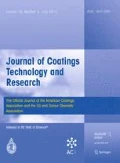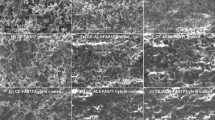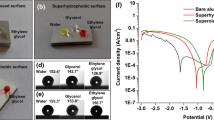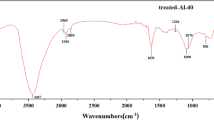Abstract
The development of the first model coatings with innovative surface structures, anti-icing, and anticontamination properties could be implemented in the EU-project CleanSky. A porous aluminum alloy structure created by anodization was filled with fluid silicon oil polydimethylsiloxane. At the surface, the silicon oil was modified with vacuum ultraviolet-light to form a thin and solid hydrophobic layer. For further investigations, laser-structured metal surfaces were copied and reproduced with a coating and afterward filled with fluoro-modified oils. Additionally, aluminum alloy AA2024 samples were pickled and treated with hot water to create micro- and nanostructures at the surface. These samples were also filled with different fluoro-modified and nonmodified oils. After application, the surface properties were analyzed with special tests for functionality regarding anti-ice and anticontamination properties.
















Similar content being viewed by others
References
Stenzel, V, Rehfeld, N, Functional Coatings. Vincetz Network, Hannover (2011)
Cassie, ABD, Baxter, S, “Wettability of Porous Surfaces.” Trans. Faraday Soc., 40 546–551 (1944)
Liangliang, C, Andrew, KJ, Vinod, KS, Jianzhong, W, Di, G, “Anti-icing Superhydrophobic Coatings.” Langmuir, 25 (21) 12444–12448 (2009)
Wong, et al., “Bioinspired Self-repairing Slippery Surfaces with Pressure-Stable Omniphobicity.” Nature, 477 443–447 (2011)
Kim, P, Wong, TS, Alvarenga, J, Kreder, MJ, Adorno-Martinez, WE, Aizenberg, J, “Liquid-Infused Nanostructured Surfaces with Extreme Anti-ice and Anti-frost Performance.” ACS Nano, 6 6569–6577 (2012)
Bohn, HF, Federle, W, “Insect Aquaplaning: Nepenthes Pitcher Plants Capture Prey with the Peristome, a Fully Wettable Water-Lubricated Anisotropic Surface.” Proc. Natl. Acad. Sci. USA, 101 14138–14143 (2004)
Hart, RK, “A Study of Boehmite Formation on Aluminium Surfaces by Electron Diffraction.” Trans. Faraday Soc., 50 269–273 (1954)
Kim, P, Kreder, MJ, Alvarenga, J, Aizenberg, J, “Hierarchical or Not? Effect of the Length Scale and Hierarchy of the Surface Roughness on Omniphobicity of Lubricant-Infused Substrates.” Nano Lett., 13 (4) 1793–1799 (2013)
Leslie, DC, Waterhouse, A, Ingber, DE, Aizenberg, JA, “A Bioinspired Omniphobic Surface Coating on Medical Devices Prevents Thrombosis and Biofouling.” Nat. Biotechnol., 32 1134–1140 (2014)
Acknowledgments
The authors would like to thank the European Union’s Seventh Framework Program (FP7/2007-2013) for the CleanSky Joint Technology Initiative under grant agreement number CSJU-GAM-SFWA-2008-001.
Author information
Authors and Affiliations
Corresponding author
Rights and permissions
About this article
Cite this article
Patzelt, G.J., Stenzel, V., Geils, J. et al. Anti-icing and anticontamination properties of coatings induced by surface structure. J Coat Technol Res 13, 589–596 (2016). https://doi.org/10.1007/s11998-015-9772-2
Published:
Issue Date:
DOI: https://doi.org/10.1007/s11998-015-9772-2




